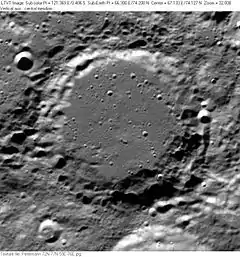Petermann (crater)
Petermann is a lunar impact crater that is located near the northern limb of the Moon, on the eastern hemisphere. It is located about 10 kilometres to the north of the crater Cusanus. Due to its location, this crater appears significantly foreshortened when viewed from the Earth, and its visibility can be affected by libration. To the west is Baillaud and to the southeast is Hayn.
 Clementine mosaic | |
| Coordinates | 74.2°N 66.3°E |
|---|---|
| Diameter | 73 km |
| Depth | Unknown |
| Colongitude | 296° at sunrise |
| Eponym | August H. Petermann |

Attached to the western rim of this crater is the large, heavily eroded crater Petermann R, which is much larger than Petermann although less prominent in appearance. The outer rim of Petermann is eroded, but retains some structure including traces of terraces. The inner wall varies in width around the perimeter, being wider to the south and southeast near Cusanus. The interior floor has been resurfaced, leaving a level plain that is marked only by a number of tiny craterlets and only a few low ridges near the sides.
Satellite craters
By convention these features are identified on lunar maps by placing the letter on the side of the crater midpoint that is closest to Petermann.
| Petermann | Latitude | Longitude | Diameter |
|---|---|---|---|
| A | 75.0° N | 87.1° E | 17 km |
| B | 72.8° N | 63.8° E | 11 km |
| C | 71.6° N | 57.7° E | 13 km |
| D | 77.1° N | 65.8° E | 31 km |
| E | 72.5° N | 53.7° E | 13 km |
| R | 75.0° N | 56.7° E | 115 km |
| S | 75.2° N | 61.9° E | 8 km |
| X | 75.1° N | 73.3° E | 9 km |
| Y | 76.0° N | 87.4° E | 13 km |
References
- Petermann, Gazetteer of Planetary Nomenclature, International Astronomical Union (IAU) Working Group for Planetary System Nomenclature (WGPSN)
- Andersson, L. E.; Whitaker, E. A. (1982). NASA Catalogue of Lunar Nomenclature. NASA RP-1097.
- Blue, Jennifer (July 25, 2007). "Gazetteer of Planetary Nomenclature". USGS. Retrieved 2007-08-05.
- Bussey, B.; Spudis, P. (2004). The Clementine Atlas of the Moon. New York: Cambridge University Press. ISBN 978-0-521-81528-4.
- Cocks, Elijah E.; Cocks, Josiah C. (1995). Who's Who on the Moon: A Biographical Dictionary of Lunar Nomenclature. Tudor Publishers. ISBN 978-0-936389-27-1.
- McDowell, Jonathan (July 15, 2007). "Lunar Nomenclature". Jonathan's Space Report. Retrieved 2007-10-24.
- Menzel, D. H.; Minnaert, M.; Levin, B.; Dollfus, A.; Bell, B. (1971). "Report on Lunar Nomenclature by the Working Group of Commission 17 of the IAU". Space Science Reviews. 12 (2): 136–186. Bibcode:1971SSRv...12..136M. doi:10.1007/BF00171763. S2CID 122125855.
- Moore, Patrick (2001). On the Moon. Sterling Publishing Co. ISBN 978-0-304-35469-6.
- Price, Fred W. (1988). The Moon Observer's Handbook. Cambridge University Press. ISBN 978-0-521-33500-3.
- Rükl, Antonín (1990). Atlas of the Moon. Kalmbach Books. ISBN 978-0-913135-17-4.
- Webb, Rev. T. W. (1962). Celestial Objects for Common Telescopes (6th revised ed.). Dover. ISBN 978-0-486-20917-3.
- Whitaker, Ewen A. (1999). Mapping and Naming the Moon. Cambridge University Press. ISBN 978-0-521-62248-6.
- Wlasuk, Peter T. (2000). Observing the Moon. Springer. ISBN 978-1-85233-193-1.